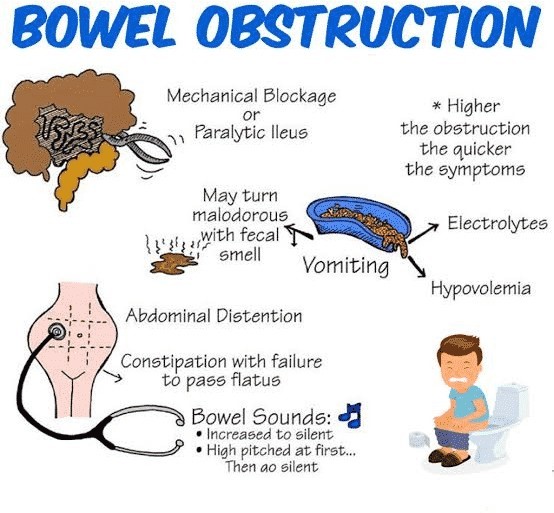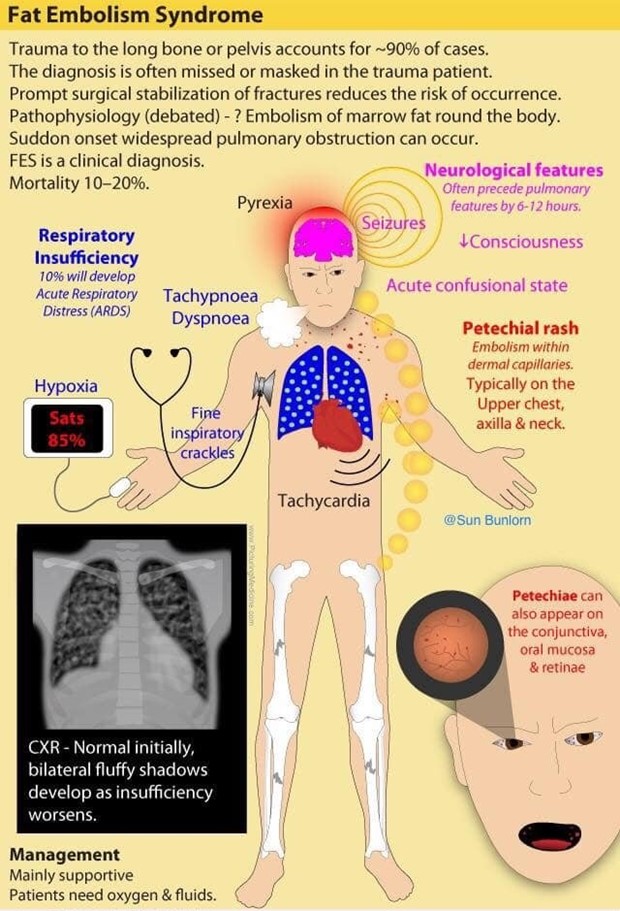A client is admitted with a small bowel (small intestine) obstruction. Which assessment findings are consistent with this diagnosis?
SELECT ALL THAT APPLY
Profuse vomiting.
Abdominal pain and distention.
Pain relieved by eating.
Blood in the stool.
Correct Answer : A,B,E
Small bowel obstruction can lead to the accumulation of gastric contents above the obstruction, causing vomiting.
Obstruction of the small bowel can result in crampy, colicky abdominal pain and abdominal distention.
Electrolyte imbalances, such as hypokalemia (low potassium), can occur due to vomiting and inadequate intake in cases of small bowel obstruction.
The following finding is not directly associated with small bowel obstruction:
Pain relief after eating is more commonly associated with peptic ulcer disease, not small bowel obstruction.
While blood in the stool can be seen in some cases of bowel obstruction, it is more commonly associated with lower gastrointestinal bleeding or other conditions affecting the colon, rather than small bowel obstruction.

Nursing Test Bank
Naxlex Comprehensive Predictor Exams
Related Questions
Correct Answer is C
Explanation
School-age children typically have a growing awareness of their bodies and an understanding of potential harm or pain. They may fear procedures or treatments that involve physical discomfort, such as injections, blood draws, or invasive procedures. The fear of experiencing pain or bodily injury can cause anxiety and distress in school-age children.
It is important for the nurse to acknowledge and address the child's fear of pain or bodily injury by providing age-appropriate explanations, offering reassurance, and implementing strategies to minimize discomfort. This may involve using distraction techniques, providing emotional support, and ensuring proper pain management during procedures.
While loss of privacy and control, separation anxiety, and stranger anxiety can also be stressors for school-age children, the fear of pain or bodily injury is often a significant concern that may require specific attention and interventions from the nurse.
Correct Answer is D
Explanation
Fat embolism syndrome can occur when fat globules enter the bloodstream after a long bone fracture, such as a femur fracture. The fat globules can travel to the lungs and cause respiratory distress and decreased oxygen saturation. The symptoms observed in the client, including tachypnea (labored breathing), decreased oxygen saturation (88%), and the presence of petechiae (small red or purple spots) on the neck and anterior chest, are consistent with fat embolism syndrome.

Fat embolism syndrome is a serious condition that requires immediate medical attention. Notifying the healthcare provider allows for prompt evaluation, confirmation of the diagnosis, and initiation of appropriate treatment. This may involve further diagnostic tests such as a chest CT scan, as mentioned in one of the options, to rule out other potential causes or complications.
Whether you are a student looking to ace your exams or a practicing nurse seeking to enhance your expertise , our nursing education contents will empower you with the confidence and competence to make a difference in the lives of patients and become a respected leader in the healthcare field.
Visit Naxlex, invest in your future and unlock endless possibilities with our unparalleled nursing education contents today
Report Wrong Answer on the Current Question
Do you disagree with the answer? If yes, what is your expected answer? Explain.
Kindly be descriptive with the issue you are facing.
